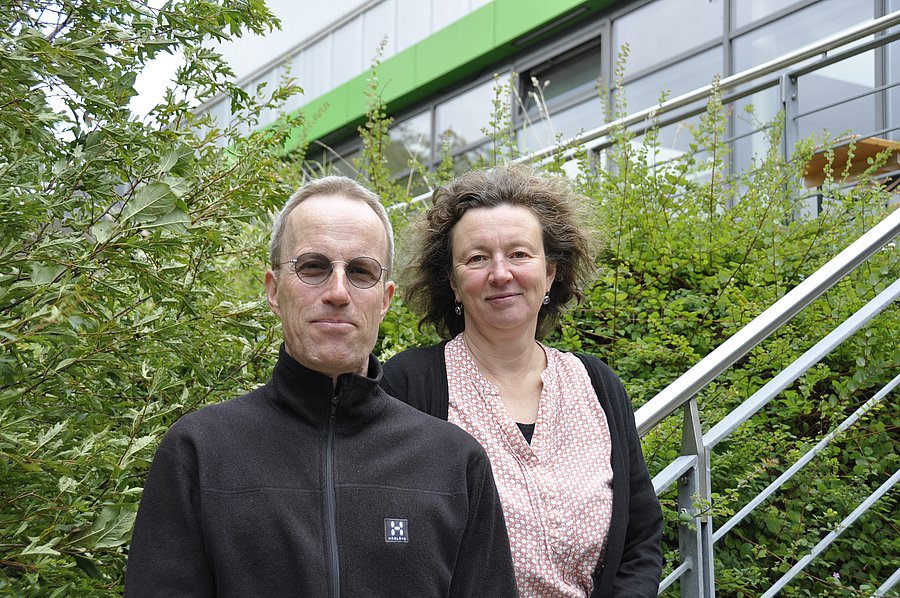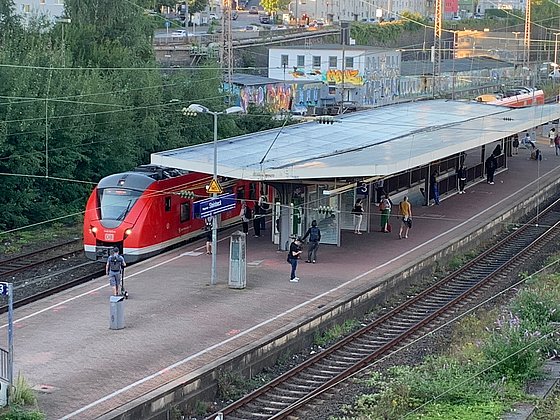
Station as a place of learning
Christine Dzubiel / History and Dr. Stefan Padberg / Geography
Photo: UniService Transfer
Station as a place of learning?
Didacticians Christine Dzubiel and Dr. Stefan Padberg find new interdisciplinary learning sites for prospective teachers.
At Bergische Universität, history and geography are two subjects that lend themselves to opening up new learning sites for students. For several years now, history didactician Christine Dzubiel and geography didactician Dr. Stefan Padberg have been working together to offer seminars that provide student teachers with didactically new opportunities to design modern and exciting lessons.
In 1974, the German Education Council introduced the term "place of learning" into the language of education policy and thus also into educational terminology. It is an institution recognized within the public education system where learning opportunities are organized. "There is practically no place of learning and no subject of learning where the historical and geographical perspectives do not meet," Dzubiel says of their collaboration, and Padberg adds, "The collaboration has developed professionally in that history and geography both belong to sciences that meet twice in teacher training programs, namely both in the subject matter teaching of the primary level and in the secondary level, where there is then specifically the subject of social studies with both perspectives. That's very enriching for students."
Learning sites are everywhere
When approaching and searching for new learning sites, the convinced didacticists* always first ask themselves the questions 'What is good learning? ` and 'What is good teaching? `. Padberg explains it this way: "We don't just want to talk about it in the seminar, but also experience it with the students. Our core idea here is, we want to stimulate and reflect on learning processes via the learning we experience together." Over the course of time, several seminars have already been held on this topic. For example, the two scientists have worked on learning sites with the content 'Rhine', 'City of Cologne', 'Wuppertal' and 'Train Stations' and will soon offer the topic 'Forest'. "We let the students freely associate with this topic," says Dzubiel. In the case of the Rhine, the students worked in small groups to find out for themselves what they found exciting about it. In this way, they were able to explore the topic as a waterway, natural space, economic area or tourist recreation area with often unexpected possibilities. "Z. For example, we visited the only vocational school for inland navigation in Duisburg," reports Dzubiel enthusiastically, "and that was sensational. You could be a captain there in a replica ship simulator and steer or navigate from a tributary into the Rhine. That was quite difficult and we all hit the wall, because you also have to consider the current conditions. This was a great learning site that the students found themselves because they always saw these ships on the Rhine and wanted to learn more about them." In order to distinguish Cologne as a learning location from the classic sights, the creators came up with an original idea. Says Padberg: "Cologne is a Catholic city, and we placed a cross over the city map and placed a marker every two centimeters. The students' task was then to discover this place for themselves as a place of learning and to make it possible for the group to experience it on site." This multi-perspective approach led to the realization that historical and geographical education can be taught at any location.
Train stations in NRW
The topic of train stations presented itself simply because Wuppertal University is a commuter university. "You can read the state of society and its development from the train stations," Dzubiel explains, "and so there's history in that." She has also noticed that many students have now consciously decided to travel to the university only by car, because they have had many negative experiences as long-suffering commuters, and adds: "I myself commuted from Bonn to Wuppertal for a very long time, getting on at a construction site in Bonn and getting off again at a construction site in Wuppertal. After all, that does something to people on their way to university." A prerequisite for the choice of stations to be studied was accessibility during an excursion day. Therefore, such interesting stations as the one in Liège (Belgium) or Milan (Italy) were ruled out from the start. "In addition to Cologne, we also had Mönchengladbach, Düsseldorf, Hagen, Essen and, of course, Wuppertal with Mirke and Steinbeck in the program," says the historian.

Steinbeck train station in Wuppertal
Photo: UniService Transfer
Steinbeck train station
Train stations have historical and also geographical potential to function as places of learning. In Wuppertal alone, active train stations such as Steinbeck or Hauptbahnhof as well as the now-defunct Mirke station are of particular importance to the city. "I think the students chose Steinbeck station because it's the station that still has the S-Bahn connection for commuting students with the nicer walk to the university and is also closer to the party district at Arrenberg," Dzubiel tells us. Furthermore, the main station with its five tracks was built tightly into the rock, while at Steinbeck station you can still see around 20 tracks. Rail passengers experience this situation every day, but without giving it a second thought. To raise awareness, a first learning process, at the beginning of the work all participants met at the main station to travel the short distance in the direction of Steinbeck. "And then the group of students who led the field trip said, 'Now pay attention to what you notice when we drive the two minutes to Steinbeck station,'" Padberg says. "And that's when they already noticed the narrow path that goes out into the distance." New questions then arose from this, such as why did people later prefer the narrow to the wide? In addition, Steinbeck was once much larger than it appears today, he said, because the large parking lot and the shopping center also used to be part of the railroad property. "There is also a vacant control house there" reports the scientist, "and that tells us a lot about the social reality. In other cities, that control house would probably be a cool restaurant or bar today. Here, it's just not being used. And getting that look for a space you think you know, to be alienated, to ask questions and explore that, is always exciting on field trips."
Students provide learning incentives for students
"In all seminars, students basically always have the task of offering their fellow students* a learning experience based on a place," explains Dzubiel, and that can't be done at the university. The design is up to the students themselves, who always come up with great ideas. "Some make really great field trip didactic offerings by organizing a scavenger hunt, or using the app 'Biparcours.' Or they organize pedestrian surveys and visit a train station mission. It's all free choice and can also only bring learning experiences to those places." In this way, the students make the place they have chosen their own; more than that, Padberg confirms, "they become experts and know about the social, historical and geographical development of this place, which they also integrate into larger concepts," because, of course, one must also think about industrialization when considering the history of train stations, for example. The goal, he said, is always for the students assigned to the site to have some kind of knowledge advantage over the other students. This would allow them to offer methods through which the others could access the content. They act as teachers, presenting themselves to their peer students in the seminar. "These learning arrangements that match their peers are a big challenge for students," Dzubiel says. In addition, Padberg adds, they naturally receive eye-level feedback on this, which is feedback on the quality of the learning process they themselves have guided. This serves the individual development into a teacher, according to what we know about the importance of the teacher as a person: "My most important tool in teaching is myself!"
Advantages and disadvantages of stations studied.
One of the final reflection papers that the two researchers *asked included the question: of which station would they like to become a station manager* for a year? "The main station in Essen came out on top because our students found it ideal that it is very closely connected to the subway, the streetcar and also to the highway, whose connection is directly behind the station," says Dzubiel. In addition, he says, it is a shopping station close to the city center where, when you enter, you can experience everything at once. The students were not so enthusiastic about Düsseldorf's main station, which they said was a real disaster in terms of accessibility. People with baby carriages or even wheelchairs had no way of reaching the tracks or the subway, and this despite the fact that the station was only rebuilt in the 1980s. In Wuppertal, things are by no means better in terms of accessibility. But that, too, can only be learned at an on-site learning site, Padberg concludes, "you don't necessarily notice that when you talk about the station."
Uwe Blass
Christine Dzubiel is an academic councilor for history and its didactics in the Faculty of Humanities and Cultural Studies.
Dr. Stefan Padberg is a research assistant in the Didactics of Teaching in the Faculty of Humanities and Social Sciences.
